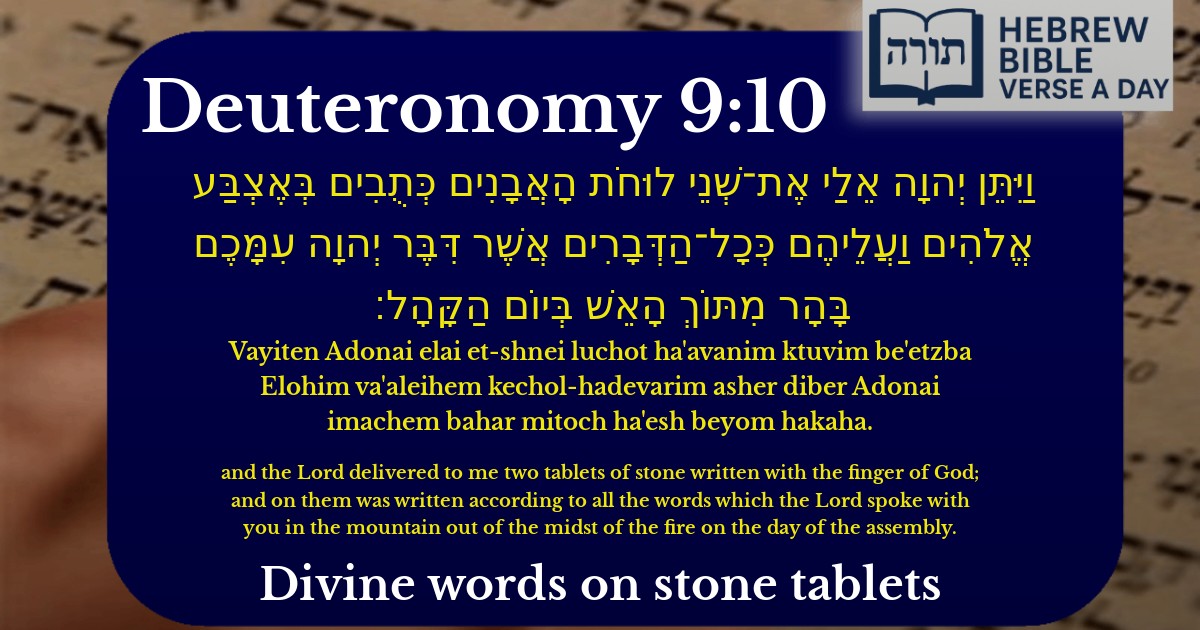Join Our Newsletter To Be Informed When New Videos Are Posted
Join the thousands of fellow Studends who rely on our videos to learn how to read the bible in Hebrew for free!
Hebrew Text
וַיִּתֵּן יְהוָה אֵלַי אֶת־שְׁנֵי לוּחֹת הָאֲבָנִים כְּתֻבִים בְּאֶצְבַּע אֱלֹהִים וַעֲלֵיהֶם כְּכָל־הַדְּבָרִים אֲשֶׁר דִּבֶּר יְהוָה עִמָּכֶם בָּהָר מִתּוֹךְ הָאֵשׁ בְּיוֹם הַקָּהָל׃
English Translation
and the Lord delivered to me two tablets of stone written with the finger of God; and on them was written according to all the words which the Lord spoke with you in the mountain out of the midst of the fire on the day of the assembly.
Transliteration
Vayiten Adonai elai et-shnei luchot ha'avanim ktuvim be'etzba Elohim va'aleihem kechol-hadevarim asher diber Adonai imachem bahar mitoch ha'esh beyom hakaha.
Hebrew Leining Text
וַיִּתֵּ֨ן יְהֹוָ֜ה אֵלַ֗י אֶת־שְׁנֵי֙ לוּחֹ֣ת הָֽאֲבָנִ֔ים כְּתֻבִ֖ים בְּאֶצְבַּ֣ע אֱלֹהִ֑ים וַעֲלֵיהֶ֗ם כְּֽכׇל־הַדְּבָרִ֡ים אֲשֶׁ֣ר דִּבֶּר֩ יְהֹוָ֨ה עִמָּכֶ֥ם בָּהָ֛ר מִתּ֥וֹךְ הָאֵ֖שׁ בְּי֥וֹם הַקָּהָֽל׃
Parasha Commentary
📚 Talmud Citations
This verse is quoted in the Talmud.
📖 Shabbat 104a
The verse is referenced in a discussion about the divine origin of the Torah and the tablets given to Moses.
📖 Avodah Zarah 44a
The verse is cited in a discussion about the uniqueness of the divine writing on the tablets.


The Divine Origin of the Tablets
The verse (Devarim 9:10) emphasizes the supernatural nature of the Luchot (tablets) by stating they were "written with the finger of God". Rashi explains that this phrase signifies the tablets were entirely a divine creation - both the stone and the engraving were made by Hashem Himself, unlike human writing which is merely applied to a pre-existing surface. The Ramban adds that this demonstrates the eternal nature of the Torah's divine authority.
The Contents of the Tablets
The text states the tablets contained "all the words which the Lord spoke with you in the mountain". The Talmud (Makot 24a) explains this refers to the complete Torah, not just the Ten Commandments. The Mechilta teaches that all 613 mitzvot were somehow contained within the Ten Commandments, which served as general principles encompassing the entire Torah.
The Significance of "Finger of God"
This unusual expression is examined by several commentators:
The Day of Assembly
The reference to "the day of the assembly" connects this event to Matan Torah at Har Sinai. The Midrash (Shemot Rabbah 29:9) describes how all Israel prophetically saw the divine "finger" writing the tablets, creating an unbreakable national witness to the Torah's divine origin. Rambam (Yesodei HaTorah 8:1) cites this as fundamental to Jewish belief - that our ancestors directly experienced revelation.
The Dual Tablets
The fact that there were two tablets carries deep symbolism: